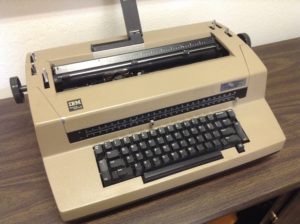At my first job after college, in the early 1980s, I used a typewriter. I worked at a fledgling non-profit magazine, so we didn’t have the Cadillac of typewriters—the IBM Selectric. Instead, we had salvaged, second hand stuff.
A few years later, working at the University of Illinois Office of Publications, I got an IBM PC with two floppy drives. One ran WordPerfect, the other was for the document files. Graphic designers gave us strict word counts based on the space afforded on their page dummies. We’d send the floppy with the WordPerfect files to a service bureau, who would then follow instructions from our designers regarding type face, size, column width, and son.
The designers would get back shiny typeset paper that they’d then paste onto their pages. If it didn’t fit, we writers would be told to cut X number of words. If there were problems due to our error, we fixed the WordPerfect file and sent it back for new typeset copy.
It was painstaking and laborious but…it enforced a discipline. Do overs literally cost money. We always strove to get everything just right the first time.
Enter Aldus Pagemaker and desktop publishing. Designers could set their own type, and fiddle with page design.
But.
The discipline that old process enforced vanished. The knowledge that it was easy to change a word or a photo at any time tempted some to constantly fiddle. Each fiddle introduced the possibility of creating new problems.
It also created a monster of sorts—the ability to use fonts, colors, and graphics—without any actual design ability. Really bad fliers and signs started popping up everywhere. At one restaurant in Urbana there were so many different desktop published placards and so many different colors and fonts that it would kill my appetite.
All that gave way to the Internet, where no document or article seems to be set in stone, to be final, and where it’s commonplace to find typos and other errors on the websites of major publications and organizations.
Of course, it’s all kind of wondrous. I mean everyone can have a web site, anyone (hey, look at me) can post a blog. And anyone can do a video or a podcast.
But probably not everyone should. Now get off my lawn!

Well, if only you had a lawn. But, I get your point. BTW, did you ever take a typing class? I took one as a senior elective in high school and it’s turned out to be time well spent.
I did take typing my senior year in HS! My mom pushed me and it paid dividends the rest of my life.
When I was 12 years old, my sister Peggi had a portable, manual typewriter (electric typewriters were uncommon then) She would not let me touch it. I couldn’t wait to learn how to type! I memorized the keyboard. QWERTYUIOP, ASDFGHJKL, ZXCVBNM with anticipation. When I got to high school and took typing classes, I found out that my memorization was for naught. That’s not how typing worked.
The IBM Selectric – in dark turquoise, please. I’m a good typist and working with that machine was like driving a 16-wheeler down the highway at 85 mph. You awakened my inner typewriter geek.
Growing up, I avoided anything that required any writing. The mandatory English 101, is still the only English course I ever took. I hated writing before I could edit on the go. Every sentence was drudgery. Word processing literally changed my life. Now I really enjoy wordsmithing. And most of my career involved quite a bit of writing. I’ll never be a great writer, but I feel like I can hold my own. (I only had to do about 10 edits on this paragraph!)
I remember when a “trainer” came to UI Office of Pubs to get us designers up to speed on Pagemaker. Her big selling point was that we could frame our text, and demonstrated it with a frame of circus peanuts. That was 1986. I was not excited. Here’s my beef about pagemaking programs: WHY are still seeing “dumb quotes” everywhere? For cry bones!!
Leave a Response